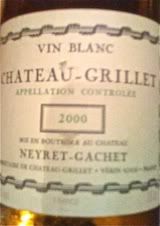Welcome once again to the second installment of our Rhone series. This week we travel just around the bend in the river from Côte Rôtie and into the viognier based wines of Condrieu and the 3.8ha enclave of Chateau Grillet. This should be interesting as this is really the only time during this series where we get to focus solely on white wines.
There isn’t a substantial difference in growing conditions than what we’ve been able to discuss regarding Côte Rôtie: south/ south-east facing steep slopes to maximize sun exposure and protection from the Mistral, but somewhat dissimilar soils. In Terroir, James Wilson explains, “the abundance of micas in the heterogeneous granites of Condrieu produces good clay binding for the gritty soils and may contribute to the suppleness which characterizes Condrieu wines with their delicate but elusive bouquet redolent of apricots and violets.”
As discussed with Côte Rôtie, the popularity of the wines in the last two decades has increased substantially and as a result, the area under vine has risen to over 100 ha. This may not seem that much, but as early as 1990, only 40 ha were legally allowed to be labeled as “Condrieu AC” wine. Additionally, vinification techniques and the use of oak vary considerably between producers… coupling this with the vineyard expansion can only add to large differentiation in styles and quality.
Moving on to Chateau Grillet, a small amphitheater within Condrieu is one of France’s smallest wine appellations. It is also a “monopole” owned by Neyret-Gache since its existence in 1830, but not granted AC until 1936. Dissimilar to many Condrieu wines that are meant to be drunk young, Ch Grillet spend 2 years in a combination of new and used oak and are meant to be drunk with maturity.
It should be noted, that although many consider this some of the best terroir for white wine in the Rhone, Isabelle Baratin, took over the winery in 1994 when the head of the estate since 1960, her father, died. Many agree that since that point, the quality of the wine has failed to live up to expectations. Then, in March of this year French billionaire, François Pinault (owner of Ch Latour and Dm d’Eugenie) purchased the property, so it will be interesting to see how this plays out.
Quick note: We went for 2 weeks on Côte Rôtie, but from here on out we will be rotating weekly, starting on Mondays according to the following schedule (as previously posted):
Saint Joseph – August 8th
Crozes Hermitage - August 15th
Hermitage – August 22nd
Cornas - August 29th
Vinsobres/ Rasteau (Dry) – September 5th
Gigondas/ Vacqueras – September 12th
Châteauneuf du Pape – September 19th
Lirac/ Tavel (Rosé) – September 26th
Beaumes de Venis (VDN)/ Rasteau (VDN)/ Saint Péray (sparkling) – October 3rd
Cheers!
